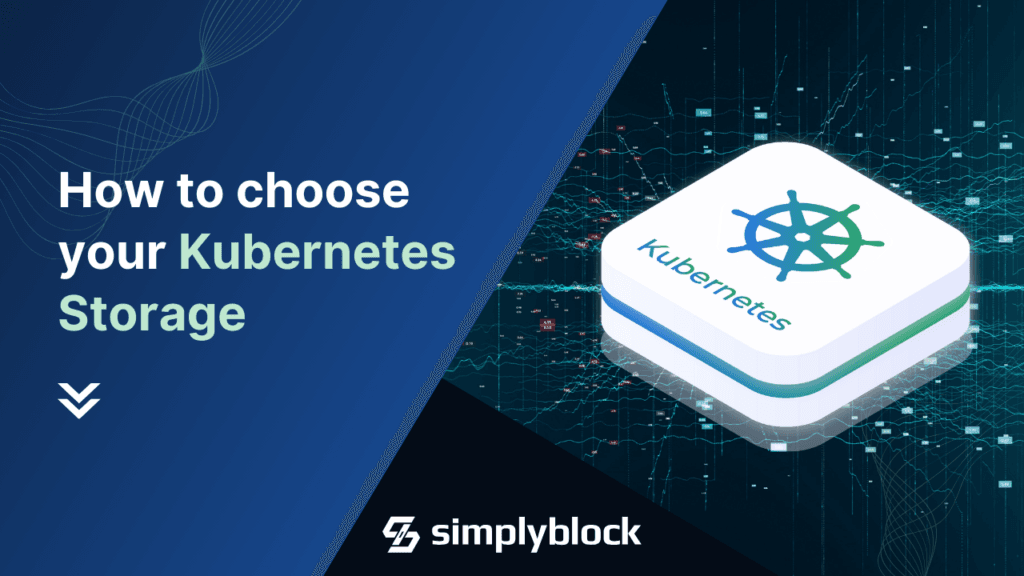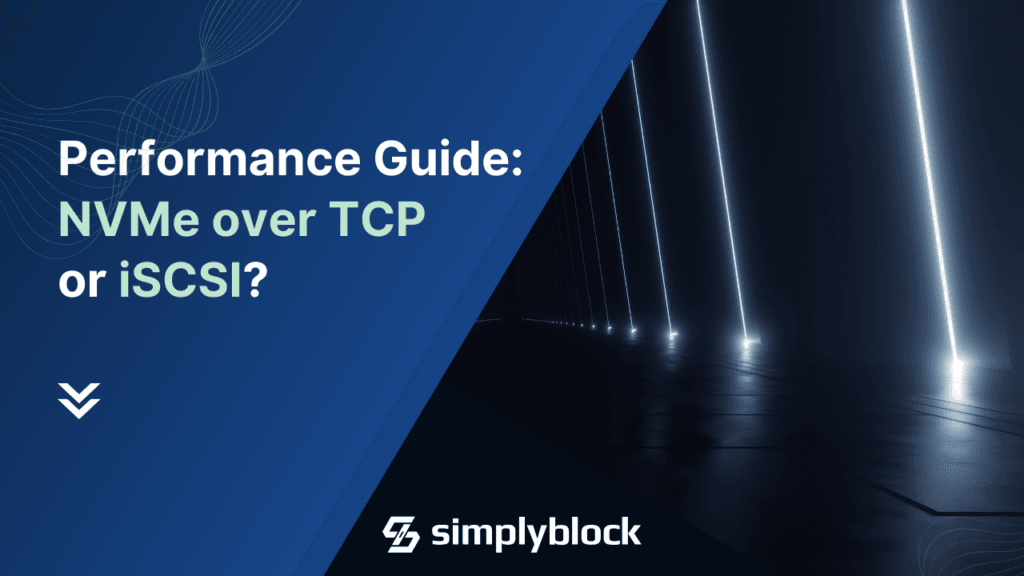
Hitachi Vantara has long been a stalwart in enterprise storage, offering robust hardware-centric solutions like the Virtual Storage Platform (VSP) series and the Hitachi Content Platform (HCP). These platforms are renowned for their reliability, scalability, and integration with hybrid cloud environments. However, as the industry shifts towards more agile, software-defined, and cloud-native storage solutions, several competitors have emerged, offering innovative Hitachi Vantara competitors that cater to modern infrastructure demands.
Moving from Hitachi Vantara to simplyblock for Scalable Storage
Simplyblock delivers a cutting-edge software-defined storage platform tailored for high-performance workloads. Its modular, adaptive, unified, shared-everything (MAUS) architecture supports NVMe over Fabrics (NVMe-oF), Kubernetes-native deployments, and seamless scalability across diverse environments. Designed to meet the demands of modern enterprises, simplyblock™ offers a robust alternative to traditional storage solutions like Hitachi Vantara.
Benefits of Simplyblock
Organizations leveraging simplyblock can expect:
- Linear Scale-Out Performance: Expand storage capacity without compromising performance.
- Advanced Erasure Coding: Enhanced data protection with efficient storage utilization.
- High IOPS Density: Optimized for demanding workloads requiring rapid data access.
- Support for ARM64 and x64: Flexibility to deploy across various hardware platforms.
- DPU Optimization: Offload storage tasks to Data Processing Units for improved efficiency.
- End-to-End NVMe-oF Support: Ensure low-latency, high-throughput storage networking.
- Application-Transparent Storage Tiering: Automatically move data between storage tiers without application awareness.
Key Differences Between Simplyblock and Hitachi Vantara
- Deployment Flexibility: Unlike Hitachi Vantara’s hardware-centric approach, simplyblock offers streamlined deployment across various infrastructures.
- Cost Efficiency: Reduce capital expenditures by leveraging existing hardware and avoiding vendor lock-in.
- Simplified Operations: Streamline management with Kubernetes-native integration and automated tiering.
- Future-Proof Architecture: Stay ahead with support for emerging technologies like DPUs and ARM64.
Trusted Enterprise Storage Providers Compared
Enterprise storage has long been shaped by trusted vendors like NetApp, Dell EMC, Pure Storage, and IBM—each offering distinct strengths across performance, scalability, and cloud integration. Let’s have a look at these Hitachi Vantara competitors.
NetApp
NetApp provides storage solutions that unify data management across on-premises and cloud environments. With offerings like the AFF series, NetApp focuses on performance, efficiency, and seamless integration with cloud services. Their ONTAP software enables consistent data services and simplified management.
Dell EMC
Dell EMC offers a broad portfolio of storage solutions, including the PowerMax and Unity XT series. These systems are designed to cater to various enterprise requirements, from high-performance workloads to cost-effective storage. Dell EMC emphasizes scalability, reliability, and integration with existing IT ecosystems.
Pure Storage
Pure Storage specializes in all-flash storage solutions, delivering high performance and simplicity. Their FlashArray and FlashBlade products are designed for modern workloads, offering scalability and ease of management. Pure Storage focuses on delivering a seamless user experience with their Evergreen Storage model.
IBM FlashSystem
IBM’s FlashSystem portfolio provides high-speed, low-latency storage solutions optimized for modern workloads. With features like AI-driven management and integration with hybrid cloud environments, IBM aims to deliver intelligent storage that adapts to evolving business needs.
Feature Comparison of simplyblock and Leading Vendors
| Feature | simplyblock™ | Hitachi Vantara | NetApp | Dell EMC | Pure Storage | IBM FlashSystem |
|---|---|---|---|---|---|---|
| Full Support for K8s-native Architectures | ✅ | ❌ | ❌ | ❌ | ❌ | ❌ |
| High IOPS Density | ✅ | ❌ | ❌ | ❌ | ❌ | ❌ |
| Ultra-Low Latency (Sub-Millisecond) | ✅ | ❌ | ❌ | ❌ | ❌ | ❌ |
| No Proprietary Hardware | ✅ | ❌ | ❌ | ❌ | ❌ | ❌ |
| Linear Scale-Out Performance | ✅ | ❌ | ❌ | ❌ | ❌ | ❌ |
| Advanced (Distributed) Erasure Coding | ✅ | ❌ | ❌ | ❌ | ❌ | ❌ |
| Application-Transparent Storage Tiering | ✅ | ❌ | ✅ | ✅ | ✅ | ❌ |
Why Simplyblock Is Built for What’s Next
Selecting the optimal storage solution is crucial for meeting your organization’s performance, scalability, and cost objectives. While Hitachi Vantara offers robust storage platforms, competitors like simplyblock provide enhanced performance, simplified management, and better integration with modern infrastructures.
Why simplyblock Stands Out
Simplyblock combines the benefits of software-defined storage with cutting-edge technologies, ensuring your infrastructure is ready for current and future demands. Its emphasis on flexibility, efficiency, and integration positions it as a superior choice for organizations seeking to optimize their storage strategy.
Questions and Answers
Emerging storage technologies like NVMe over TCP, software-defined storage (SDS), and cloud-native storage are disrupting traditional storage models. These innovations offer higher performance, better scalability, and greater flexibility, which make them strong competitors to Hitachi Vantara’s legacy hardware systems. For example, Simplyblock leverages NVMe over TCP to optimize data throughput and latency, positioning it ahead of hardware-centric storage systems like those from Hitachi Vantara.
NVMe over TCP provides significant improvements in latency, throughput, and IOPS, which are crucial for high-performance workloads. Simplyblock’s adoption of NVMe over TCP offers superior storage performance when compared to traditional hardware-based systems from Hitachi Vantara. This technology enables Simplyblock to outperform legacy storage solutions with faster data access and greater efficiency, catering to the growing demand for high-speed storage.
Cloud-native storage enables businesses to seamlessly scale their storage resources, integrate with cloud environments, and automate management tasks. Unlike Hitachi Vantara’s hardware-based storage systems, Simplyblock offers cloud-native storage solutions that are more flexible, cost-effective, and easier to deploy in dynamic cloud environments. Cloud-native storage eliminates the constraints of on-premise hardware, providing a competitive advantage over traditional storage platforms.
Software-defined storage (SDS) offers businesses cost savings, flexibility, and scalability without the need for proprietary hardware. Companies are increasingly moving away from Hitachi Vantara’s hardware-centric storage solutions because SDS allows for easier integration with existing IT environments and better control over storage resources. Simplyblock’s SDS platform is designed to meet modern infrastructure needs, providing more adaptability and reducing dependency on costly hardware.
IBM FlashSystem has introduced AI-driven storage management, offering intelligent features like predictive analytics and automated optimization. These innovations help businesses achieve better storage efficiency and performance. Similarly, competitors like Simplyblock leverage software-defined storage with cutting-edge technologies to deliver smarter storage solutions. These advancements position IBM FlashSystem and Simplyblock as formidable competitors to Hitachi Vantara’s more traditional storage systems.



